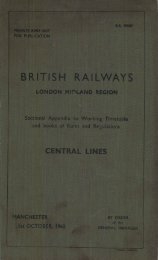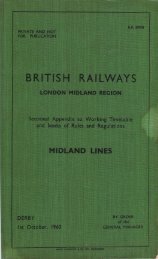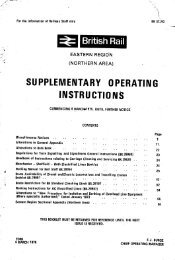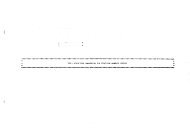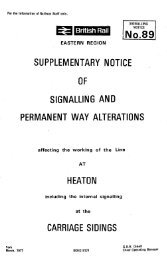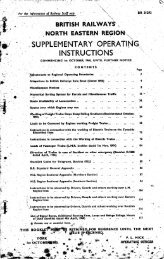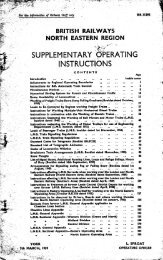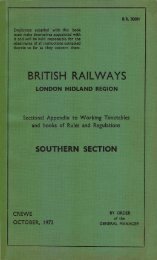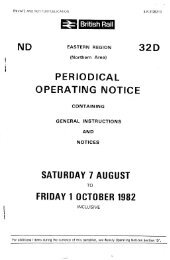general instructions. - Limit Of Shunt
general instructions. - Limit Of Shunt
general instructions. - Limit Of Shunt
You also want an ePaper? Increase the reach of your titles
YUMPU automatically turns print PDFs into web optimized ePapers that Google loves.
278 S i n g l e Li<br />
nes.—Continued.<br />
Regulations for Working Single Lines of Railway over which<br />
passenger trains DO NOT RUN, by Train Staff, Train Staff<br />
and one Train Staff Ticket, or by Train Staff and Train Staff'<br />
Tickets.<br />
1.--On lines which are worked with a train staff and train staff tickets, or a<br />
train staff and one train staff ticket only, the Regulations as shown for working<br />
single lines with train staff and train staff tickets must be observed (see pages<br />
3 to 8), together with the following additional Regulations :—<br />
2.—Where a staff and one ticket only is in use, in the event of there being one<br />
engine only to go on to the line, the ticket must be attached to the staff by the<br />
signalman or person in charge of that end of the section at which the engine<br />
enters, so that a driver may know that he has full possession of the line, and<br />
drivers carrying the staff only, will understand that there is a train in advance,<br />
and must run with caution accordingly.<br />
3.—On those lines where a staff only is used, only one engine must be allowed<br />
on the line at one time, except as shewn in Clause 4, and it must in all cases<br />
carry the staff, except on those lines where authority is given for trains to<br />
run coupled, marked on the following list thus IT, when they must be considered<br />
as one train, and the driver of the last engine must carry the staff, but it<br />
must be shewn to the driver of the front engine, who must know that the rear<br />
driver has it in his possession.<br />
4.—Where a staff only is used, and more than one engine is allowed upon the<br />
line at one time, the driver of the last engine must carry the staff and the drivers<br />
of all preceding engines must see the staff before entering upon the single line.<br />
5.-1n all cases when one engine has been allowed to precede another on to<br />
the single line, the driver of the engine following must be made aware of the fact<br />
by the signalman or person in charge of that end of the section, except at those<br />
places where the drivers deal with the staff working, when a driver who leaves<br />
,<br />
without the staff must acquaint the driver or drivers who have to follow him<br />
that he is about to do so.<br />
6.—On lines marked §, should an engine be at the opposite end of the branch<br />
with the staff, and a second engine arrive at the Junction and signal by two<br />
crow whistles that it requires to enter the Branch, the engine at the opposite<br />
end must immediately return to the Junction with the staff, so as to admit the<br />
second engine.<br />
7.—In the event of a train or engine becoming disabled and requiring assistance,<br />
or an accident occurring which renders it impossible for the engine to<br />
proceed, the fireman must take the staff and make the best of his way to that<br />
end of the section whence assistance can be obtained, and inform the person in<br />
charge there of the circumstances, who must, on receipt of such information,<br />
allow a second engine to enter the section.<br />
Should the driver of the disabled engine carry a ticket, the guard, or if it be<br />
a light engine, the fireman, must take immediate steps to protect the train orengine<br />
in accordance with General Rule 217, when the fireman must proceed<br />
to that end of the section where the staff is.<br />
The relieving engine must be accompanied by the fireman of the disabled<br />
engine or train, who must hand the staff to the engine driver and explain to him<br />
where, and under what circumstances, the disabled engine or train is situated.<br />
The driver of the disabled engine must not allow it to be removed until the<br />
assisting engine has arrived.




